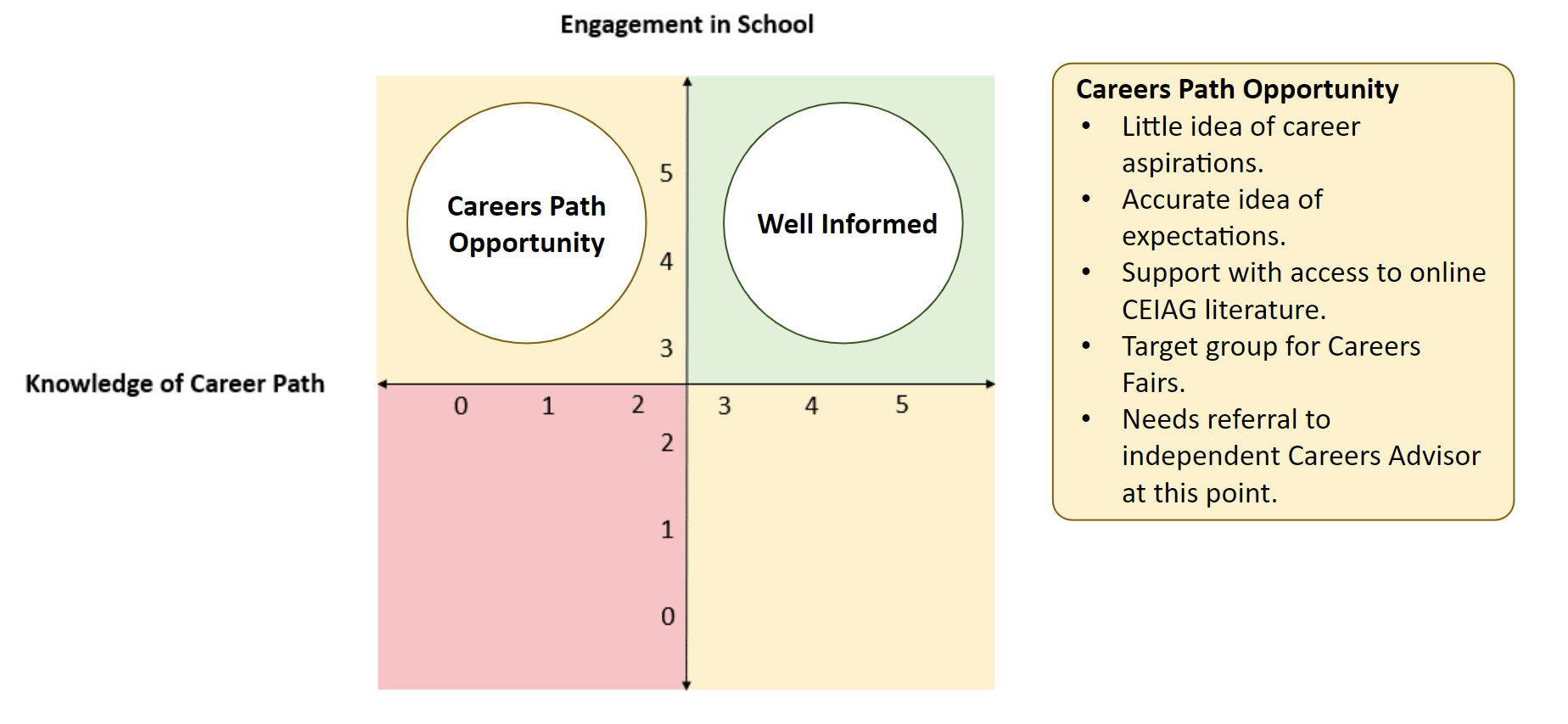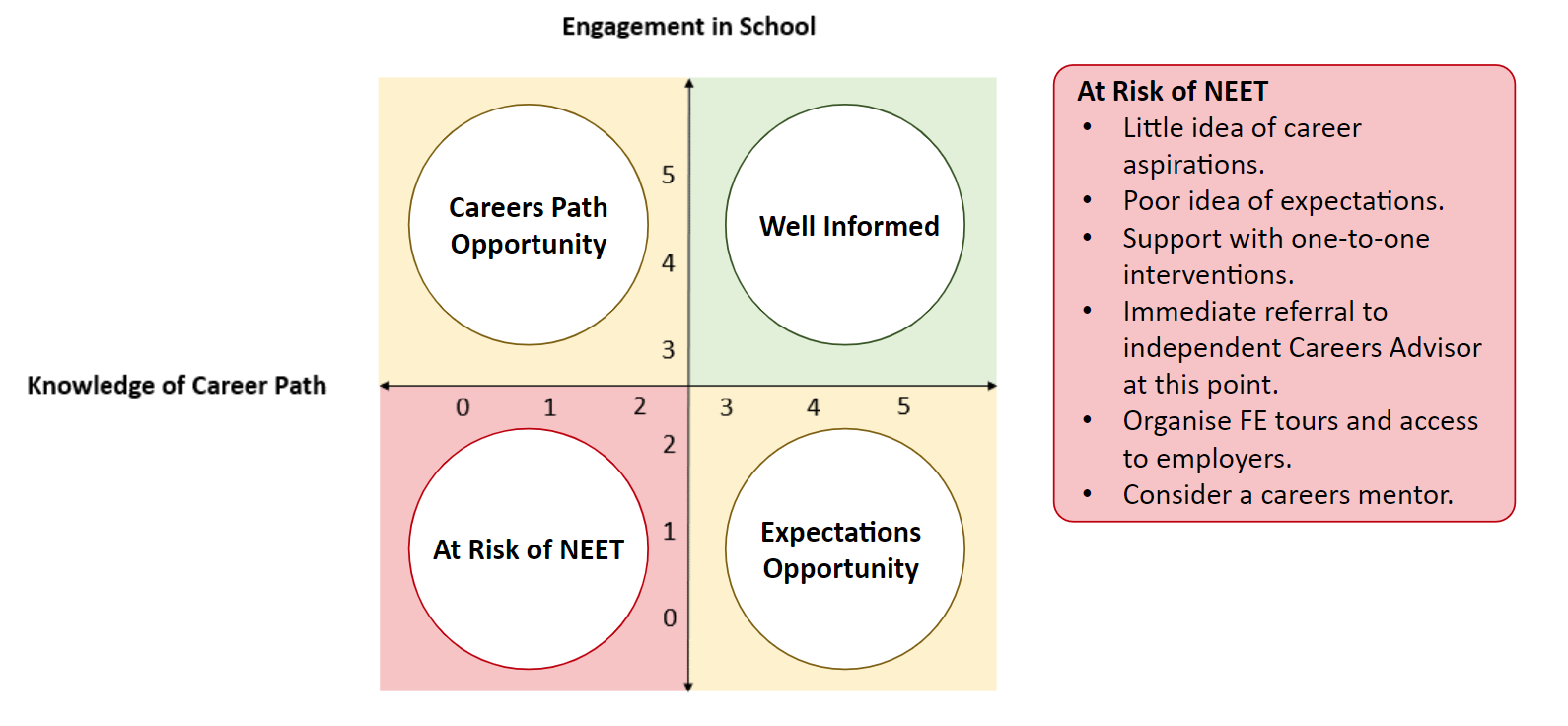Meden Quadrants - ResearchED National 2022
Introduction
It struck me that despite introducing this technique for assessing CEIAG intervention need, I had not given this method a name. "Hill's Quadrants" seemed a bit egocentric, and seeing as their first use will be applied in a particular setting, Meden Quadrants seemed to be the most appropriate choice here.
The interventions used are easily adjusted to your school/college's context and CEIAG provision, and these initial ones may well be adjusted as we develop their use - which I will write more about as our CEIAG curriculum and provision develops.
Meden Quadrants as a concept
The premise behind Meden Quadrants is to provide two scores for a student to determine the most appropriate intervention approach throughout their school journey. The first score (0-5) is reflective of a student's career path knowledge, this is plotted against a second (0-5) score for their (academic) engagement in school, on a chart as per figure 1 below.

figure 1 - The Meden Quadrants framework.
This scoring can be done throughout the wrap-around CEIAG provision, ideally from Year 7 through to Year 13. Plotting scores against each other places a student in one of four quadrants that firstly assess the urgency of need, and secondly the potential interventions available in a "right time, right intervention" approach. This prevents the rushed nature often found when addressing at risk of NEET (Not in Education, Employment, or Training) students in Year 11, when it is arguably a last-ditch attempt to provide support that could have been provided in a more effective and timely manner.
Quadrant 1 - "Well Informed"

figure 2 - Well Informed students
These students have a good idea of their desired career path, and have probably already engaged with their 'next steps' already. They have an accurate idea of the expectations that their next step/chosen career has from an academic stand-point, but is likely to benefit from tailored experiences to enrich their application toward the next-steps of their career path. This could be in the form of engaging with speakers from that sector, visits to stakeholder sites for experience days, or connection with FE/HE providers to visit departments, alongside making them aware of open days.
Well Informed students are a low risk of becoming NEET, need less steering toward their desired career, and have the potential to be less engaged in generic careers events that they see as being less applicable to their needs.
Quadrant 2 - "Careers Path Opportunity"
 figure 3 - Careers Path Opportunity students
figure 3 - Careers Path Opportunity students
These students have a little idea of their desired career path, but they do have an accurate idea of the expectations that the school has from an academic stand-point. These students would understand that while they are unsure of their career path, ensuring they have as many good GCSE passes as possible keeps their options for making a career-choice later open.
Careers Path Opportunity students are at a medium risk of becoming NEET, as their academic qualifications will provide opportunities for them to move to FE/HE, gain a job or apprenticeship. However, they pose a risk of NEET due to them not being sure of a career field to focus their energy toward. These students would benefit from access to online resources around careers in areas they express an interest in - possibly influenced more by the love of a subject than the need of a subject to enter a career. This group is the target audience for careers fairs, employer engagement, and speakers from FE/HE. They should be referred to the school/college's independent Careers Advisor at this point.
Quadrant 3 - "Expectations Opportunity"

figure 4 - Expectations Opportunity students
These students have a clear idea of their desired career path, but they do not have an accurate idea of the expectations that the school or employer has from an academic/character stand-point. These students may have been given inaccurate careers advice from their own network outside of the school, and would benefit from independent careers advice to address this. Often these students will present a challenge to engage academically with subjects they feel are not required to progress into the career they aspire to enter. This may also manifest in challenging behaviour in these lessons due to a drop in their attitude to learning.
Expectations Opportunity students are at a medium risk of becoming NEET, but more of a concern than Careers Path Opportunity students, as their attitude for learning and career-misconceptions puts them at risk of not meeting the minimum require academic qualifications for them to move to FE/HE, gain a job or apprenticeship. This set-back may see them enter a career path that is not their first choice, before becoming disengaged (often whilst in FE), and dropping out of their next step destination. These students would benefit from access to online resources around careers in the area they express an interest in to counter any inaccurate careers advice they have gained from outside of the school's CEIAG channels. This group is also the target audience for careers fairs, employer engagement, and speakers from FE/HE to ensure that the need to meet academic expectations is reinforced from those responsible for their next steps. They should be referred to the school/college's independent Careers Advisor at this point. If possible, these students would benefit from either an in-school or industry academic mentor to help support them to catch up if they have fallen behind, or to provide encouragement to work toward their career goals.
Quadrant 4 - "At Risk of NEET"

figure 5 - At Risk of NEET students
These students have little idea of their desired career path, a poor idea of the expectations that the school or employer has from an academic/character stand-point. These students may have been given inaccurate careers advice from their own network outside of school, or may not have a network that has the experience to facilitate these conversations. They would benefit from immediate independent careers advice to address this. Often these students will present a challenge to engage academically with subjects due to apathy and feeling out of control regarding their own career choices. This may also manifest in challenging behaviour in these lessons due to a drop in their attitude to learning.
At Risk of NEET students would benefit from one-to-one support interventions to address this. They may need a scaffolded approach when engaging with careers fairs, and would benefit from as much exposure to the world of work and FE opportunities as possible to help them make informed choices regarding the next steps on their career path.
Meden Quadrants in practice
Effective CEIAG provision should be seen as the responsibility of all teaching and pastoral staff that engage with a student. As such, the Careers Lead and independent Careers Advisor rely on information gathered from those engaging with students on a daily basis. An overview can be gained of student CEIAG needs through scoring students to ensure the most appropriate intervention can be tailored and delivered at the most appropriate time. This process should begin as soon as the school's CEIAG curriculum begins (8-13 to meet statutory requirements). Students may move between quadrants throughout their time in education, and their priority access to interventions can be adjusted accordingly. Thus providing a clearly individualised programme of careers education, information, advice and guidance with targeted interventions to meet their needs at the time they will benefit most from them.
Data can be collected formally, in the form of a marksheet with each quadrant given a code, and the data sorted to provide a picture of needs by year group, or more informally via email to the Careers Lead with an indication that a student meets the criteria for any particular quadrant, and should be flagged as such for intervention. This should be logged and kept as part of the required records of CEIAG interventions each student receives.
Liaising with the school's pastoral team and subject leaders student movement into risk or opportunity areas can be highlighted and discussed as part of a wider whole-school strategy of student and parent/carer engagement to ensure that students are supported to write their next chapter and become the best version of themselves that they can be.
Conclusion
In conclusion, the use of Meden Quadrants can support the delivery of the most appropriate CEIAG interventions that can be tailored to student needs at the time they need them most. This could be as simple as letting a student know they have been selected to attend a careers fair, or employer engagement opportunity, passing them the details of a careers website or literature at the right time to (re)focus them on their studies, or arranging for them to talk to a suitable mentor to discuss their career aspirations and how they can achieve them. CEIAG can be an effective tool in raising aspirations as part of a whole-school strategy, and should be used as such, rather than a Gatsby benchmarks box-ticking exercise to meet the needs of an Ofsted inspection.